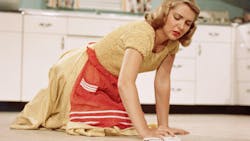A review of suggested cleanliness ranges for hydraulic components and absolute element ratings to achieve the desired cleanliness is shown in Table 1. Types of available filtration include tank breathers, return line, pressure line, and kidney (also called off-line) filters.
Fluid already in a system is typically cleaner than any new fluid that you will add; new oil is not necessarily clean, typically 22/20/18. Therefore, you should follow good practice and use a filter cart or pre-filtered fluid whenever you add fluid to keep it within cleanliness level specification. Normally, a 3-µm absolute rated filter element would be used.
Take a Breather
The next problem area could be the tank breather. Two main types are available: one type is a filter element only and the other combines water removal with filtration. The filter-element-only type has been in use for years. The biggest problem with them is that they are either removed and left off or never changed. This effectively eliminates any filtration due to dirt ingression from the air. It also opens the tank to water ingression.
A good practice is to change this type of breather at least twice per year and use at least a 10-µm absolute rated element. Note, a 10-µm absolute rated element in liquid is typically rated at least 3-µm for air.
The other type of breather typically includes a water removal portion consisting of silica beads. This type helps eliminate water from entering the tank. It typically turns color when the beads absorb water. It is good practice to change the breather once the beads change color.
If the breather changes color in a relatively short period of time, indicating a very wet environment, a better alternative would be to consider closing the tank and incorporating a product similar to Parker Hannifin's Kleen-Vent Reservoir Isolators. These units protect against ingestion of airborne contaminants and provide a positive separation of gas volume and atmosphere without the possibility of clogging or need for maintenance.
Return-Line Options
The return-line or tank-top filter is typically used in industrial systems because it is the least expensive type of absolute filtration. The micron rating should always be equal to or better than any pressure filtration that may be on the system. For example, if the pressure filters use a 6-µm absolute rated element, then the return line should be 6- or 3-µm absolute rated.
All filters should be mounted with a differential-pressure indicator, so the elements can be changed before the filters become clogged with dirt. Without indicators, there is no good way to tell if the filters are clogged unless your company regularly does oil analysis. In general, without large amounts of dirt ingression, fluid must pass throught a filter at least seven times to reach the desired cleanliness range.
Other Filters
A pressure filter is typically installed to protect contaminant sensitive components, such as servo and proportional valves. A filter, in particular on the pilot lines to these valves, will extend the life by two to three times. It is always a good practice to use a 3-µm absolute rated filter for these applications.
Kidney loop, or off-line filters, are important as polishing filters. The dynamics of many systems do not allow for smooth, linear flow through the filters — nor do they have uniform dirt ingression. The result of this can be higher than expected ISO cleanliness readings for a given micron rated element. In these cases, a kidney loop filter is invaluable to obtain the desired cleanliness. The micron rating should always be equal to or better than any pressure filtration that may be on the system.
Oil Analysis
It is important to benchmark the system or systems for any good preventive maintenance program. Two main options are available. The first is particle counting — either by your own personnel or by sending out bottled samples to a qualified lab. The advantage of doing your own particle counting is real-time readings — you can address any problems immediately. In addition, doing on-line particle counting eliminates any potential problems caused by dirty bottles or poor bottle sampling techniques. It should be noted that very clean fluid (i.e., 15/13/10 or better) is extremely sensitive to poor bottle sampling techniques. Some particle counters also provide water sensors. The disad-vantage of on-line particle counting is no analysis of wear metals, etc. This information still needs to come from a qualified fluid lab.
Is New the Same as Clean?
System maintenance brings opportunities for additional ingression of contamination. Do not assume new components are clean unless specified as such. In most cases, new components are dirtier than the existing system and care should be taken accordingly. It is good practice whenever possible to run-in new components while minimizing functions in the rest of the circuit, especially sensitive components.
Lastly, a word of caution. Some fluid producers are suggesting that there is a too clean line that should-n't be crossed. They claim that too fine of filtration can remove their anti-foaming agents. An indication of this is a jelly-like substance on the element upon change-out. Before changing to a better level of filtration, it is best to check with your fluid supplier to understand any limitations.
For more information, contact Tony Grythe, of MP Filtri USA at (215) 529-1300, email [email protected], or visit www.mpfiltriusa.com.
About the Author

Leaders relevant to this article:


